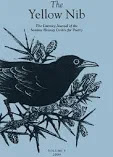Hanmer’s Agate: Experiments of a Tulip Fancier,
Sir Thomas Hanmer (1612-1678)
Returned from exile, he stands in a muddy field,
once his garden of formal parterres;
the trees are war-torn, storm-slashed; fireweed
rages through the grounds and the unhinged door
into the great hall; mice rampage,
bird shit weeps on the lace and lovelock
of his portrait as a young man; dung in the chapel
requisitioned for Parliamentarian horses.
Far from the Commonwealth’s courts, Sir Thomas
tends his garden, remembering the promise packed
in papery brown bulbs brought back from France
in the ship’s hold, his first wife left behind in her grave.
He plants the knot-garden they’d planned together: auriculas,
ranunculas, anemone and above all, tulips:
Belle Isabelle, Belle Susanne and Agates.
They rot in the wet Flintshire soil.
Should he sprinkle wine on the earth with incantations
to the moon? No. But after much experiment,
he shares his success with a fellow tulip-fancier,
Cromwell’s second-in-command.
To Major-General John Lambert,
From Sir Thomas Hanmer, Bart.
Plant them about the full moon in September,
in soil taken from mould from the fields or woodstacks
and mix with a 4th part or more of sand.
A gift of beauty, beyond faction: the mother-root
of the most exquisite and gallant, a tulip agotted
with scarlet, and gris de lin on pure white,
well parted, its base and stamens blue.
(First published in Magma: the European edition, April, 2018.)
I tell my husband I am pregnant and he sets out to make a tiny coffin (1891)
I choose a name: Mhairi or Callum.
He searches the tide-wrack daily for driftwood.
He forbids me to make clothes
But I make sheets for the coffin-crib.
There will be clean linen until the last
while I will rock and croon to my babe
for the few blessed days of its life.
It is God’s will. I shut out imaginings:
the fourth or fifth night,
when the babe gives up sucking;
the seventh, clenched gums,
even for my finger dipped in water.
I am knitting a shawl of such intricacy,
nothing so beautiful will have been seen before.
(Published in ‘Northwords Now.’)










